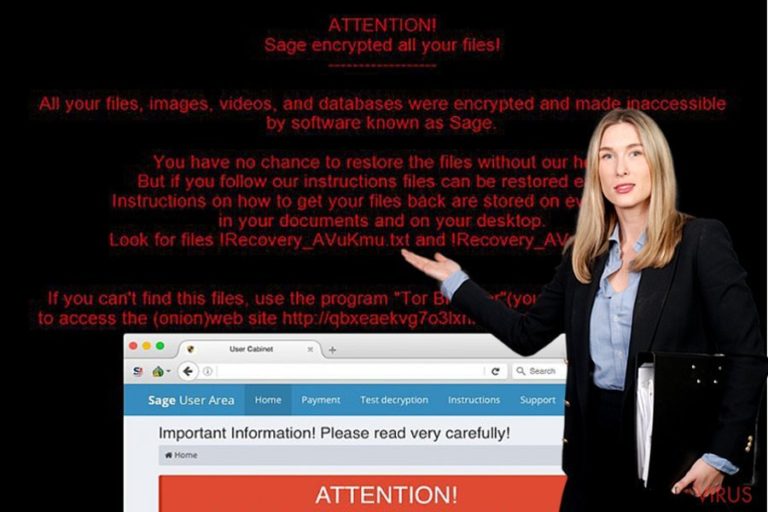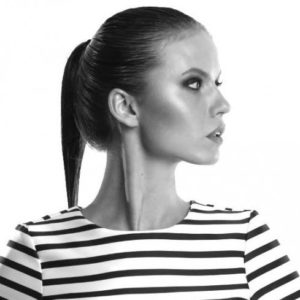Uninstall Sage virus (Virus Removal Instructions) - Free Removal Guide
Sage virus Removal Guide
Description of Sage ransomware
Sage ransomware. Another virus with a well-designed ransom payment page
Sage virus is another professional ransomware that can compete with viruses like Cerber. Just like any other illegal program, Sage malware sneaks into the computer system after making the victim believe that it is a legitimate file. As soon as it gets into the system, it executes itself and encrypts files stored on the system with a RSA-4096 cipher. During this process, the virus also decorates each corrupted file with a .sage file extension. Following a successful encryption, Sage ransomware replaces current computer background with [6 random chars].bmp, which holds information about the cyber attack and says that the victim must open !Recovery_[6 random chars].txt or !Recovery_[6 random chars].html file and learn how to get the encrypted files back. These files contain commands that tell the victim to go to a particular website. First of all, the victim needs to confirm that one is not a robot and enter a combination of symbols shown in a picture. Then, one shall proceed to an individual ransom-payment website, which has five different pages – Home, Payment, Test decryption, Instructions, and Support.

The payment website contains a lot of text regarding the encryption procedure. The virus seeks to convince the victim that there is no way to decrypt files except paying the ransom. Samples of Sage that we have encountered asked for 0.2 – 0.7 Bitcoins, which means that cyber criminals are testing different ransom prices to see how willingly victims pay it. Sadly, ransomware is a powerful virus, and unless the developer is a complete fool, there is no way to restore files without a private key that is created during the encryption process – it is also known as the decryption key, which can be used for data recovery. However, we usually do not advise paying the ransom because cyber criminals rarely show any interest to interact with victims after infecting their computers. They just seek to collect payments; therefore, if you have been infected with such malware, better start Sage removal process instead of buying Bitcoins for cyber criminals and willing to get Sage_Decryptor.exe. To remove Sage virus, we highly recommend using anti-malware program like FortectIntego or SpyHunter 5Combo Cleaner.
Update. At the beginning of 2017, the second version of this virus emerged. Sage 2.0 virus reportedly spreads via .ZIP archives that contain another .ZIP archive inside. The final .ZIP archive has either a malicious Word or JS file, which, once executed, downloads and installs Sage 2.0 ransomware on the system. The updated variant of Sage has excluded the “Test Decryption” page from the ransom payment page, and this time it demands for a much larger ransom – about 2 Bitcoins. The virus also adds .sage file extensions to target files that it encrypts and drops !Recovery_[3 random chars].html ransom note on desktop. More information about Sage v2.0 malware can be found here.
How could I allow ransomware to infect my computer?
Unfortunately, ransomware authors are very sneaky. They craft professional-looking email messages and send them out to thousands of recipients. Such emails usually contain one malicious file attachment that executes the ransomware virus on the system. Additionally, scammers might send out letters with malicious URLs or images that contain URLs to websites that host exploit kits. Exploit kits can be used for ransomware distribution. Finally, it is possible (and very likely) to download malware alongside pirated software. If you want to stay away from shady content online, better not click on anything that raises at least a bit of suspicion to you. Of course, it is highly recommended to install trustworthy anti-malware program for your safety.
How can I remove Sage ransomware from my PC?
If you think that it will be easy to remove Sage virus, you are wrong. Ransomware, unlike legitimate programs, tends to drop dozens of randomly named files on the system, and it is very hard to recognize them. Therefore, we suggest using a special software for ransomware elimination. Our team recommends anti-malware programs because unlike traditional antivirus, they can detect and remove less-dangerous computer threats that belong to spyware or malware category. Below, we provide an informative guide on how to complete Sage removal without a computer technician’s help. If you have any questions, send them to our support team.
Getting rid of Sage virus. Follow these steps
In-depth guide for the Sage elimination
Important! →
The elimination guide can appear too difficult if you are not tech-savvy. It requires some knowledge of computer processes since it includes system changes that need to be performed correctly. You need to take steps carefully and follow the guide avoiding any issues created due to improper setting changes. Automatic methods might suit you better if you find the guide too difficult.
Step 1. Launch Safe Mode with Networking
Safe Mode environment offers better results of manual virus removal
Windows 7 / Vista / XP
- Go to Start.
- Choose Shutdown, then Restart, and OK.
- When your computer boots, start pressing the F8 button (if that does not work, try F2, F12, Del, etc. – it all depends on your motherboard model) a few times until you see the Advanced Boot Options window.
- Select Safe Mode with Networking from the list.

Windows 10 / Windows 8
- Right-click the Start button and choose Settings.

- Scroll down to find Update & Security.

- On the left, pick Recovery.
- Scroll to find Advanced Startup section.
- Click Restart now.

- Choose Troubleshoot.

- Go to Advanced options.

- Select Startup Settings.

- Press Restart.

- Choose 5) Enable Safe Mode with Networking.
Step 2. End questionable processes
You can rely on Windows Task Manager that finds all the random processes in the background. When the intruder is triggering any processes, you can shut them down:
- Press Ctrl + Shift + Esc keys to open Windows Task Manager.
- Click on More details.

- Scroll down to Background processes.
- Look for anything suspicious.
- Right-click and select Open file location.

- Go back to the Process tab, right-click and pick End Task.
- Delete the contents of the malicious folder.
Step 3. Check the program in Startup
- Press Ctrl + Shift + Esc on your keyboard again.
- Go to the Startup tab.
- Right-click on the suspicious app and pick Disable.

Step 4. Find and eliminate virus files
Data related to the infection can be hidden in various places. Follow the steps and you can find them:
- Type in Disk Cleanup in Windows search and press Enter.

- Select the drive (C: is your main drive by default and is likely to be the one that has malicious files in) you want to clean.
- Scroll through the Files to delete and select the following:
Temporary Internet Files
Downloads
Recycle Bin
Temporary files - Pick Clean up system files.

- You can also look for other malicious files hidden in the following folders (type these entries in Windows Search and press Enter):
%AppData%
%LocalAppData%
%ProgramData%
%WinDir%
After you are finished, reboot the PC in normal mode.
Eliminate Sage using System Restore
-
Step 1: Restart your computer in Safe Mode with Command Prompt
Windows 7 / Vista / XP- Go to Start → Shutdown → Restart → OK.
- As soon as your computer starts, start pressing F8 key repeatedly before the Windows logo shows up.
-
Choose Command Prompt from the list

Windows 10 / Windows 8- Click on the Power button at the Windows login screen, and then press and hold Shift key on your keyboard. Then click Restart.
- Then select Troubleshoot → Advanced options → Startup Settings and click Restart.
-
Once your computer starts, select Enable Safe Mode with Command Prompt from the list of options in Startup Settings.

-
Step 2: Perform a system restore to recover files and settings
-
When the Command Prompt window appears, type in cd restore and press Enter.

-
Then type rstrui.exe and hit Enter..

-
In a new window that shows up, click the Next button and choose a restore point that was created before the infiltration of Sage and then click on the Next button again.


-
To start system restore, click Yes.

-
When the Command Prompt window appears, type in cd restore and press Enter.
Bonus: Restore your files
Using the tutorial provided above you should be able to eliminate Sage from the infected device. novirus.uk team has also prepared an in-depth data recovery guide which you will also find above.If you have a backup, just remove the virus and plug the data storage disk/drive into your computer to import files. If you do not have it, try methods described below.
There are a couple of methods you can apply to recover data encrypted by Sage:
Use Data Recovery Pro tool
As long as there are no tools capable of decrypting .sage file extension files, we advise using this data recovery software.
- Download Data Recovery Pro;
- Install Data Recovery on your computer following the steps indicated in the software’s Setup;
- Run the program to scan your device for the data encrypted by Sage ransomware;
- Recover the data.
Look for Windows Previous Versions
If you have created a system restore point, you can use this method now. You can recover individual files with a help of this trick:
- Right-click on the encrypted document you want to recover;
- Click “Properties” and navigate to “Previous versions” tab;
- In the “Folder versions” section look for the available file copies. Choose the desired version and press “Restore”.
It is strongly recommended to take precautions and secure your computer from malware attacks. To protect your PC from Sage and other dangerous viruses, you should install and keep a powerful malware removal tool, for instance, FortectIntego, SpyHunter 5Combo Cleaner or Malwarebytes.
How to prevent from getting ransomware
A proper web browser and VPN tool can guarantee better safety
As online spying becomes an increasing problem, people are becoming more interested in how to protect their privacy. One way to increase your online security is to choose the most secure and private web browser. But if you want complete anonymity and security when surfing the web, you need Private Internet Access VPN service. This tool successfully reroutes traffic across different servers, so your IP address and location remain protected. It is also important that this tool is based on a strict no-log policy, so no data is collected and cannot be leaked or made available to first or third parties. If you want to feel safe on the internet, a combination of a secure web browser and a Private Internet Access VPN will help you.
Recover files damaged by a dangerous malware attack
Despite the fact that there are various circumstances that can cause data to be lost on a system, including accidental deletion, the most common reason people lose photos, documents, videos, and other important data is the infection of malware.
Some malicious programs can delete files and prevent the software from running smoothly. However, there is a greater threat from the dangerous viruses that can encrypt documents, system files, and images. Ransomware-type viruses focus on encrypting data and restricting users’ access to files, so you can permanently lose personal data when you download such a virus to your computer.
The ability to unlock encrypted files is very limited, but some programs have a data recovery feature. In some cases, the Data Recovery Pro program can help recover at least some of the data that has been locked by a virus or other cyber infection.







